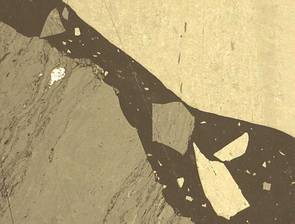Coal Blends Accreditation Program
| January 29, 2013 | Filled under Com III |
|
established in 2004 (Budapest)
Conveners
Dr. Isabel Suárez Ruiz 1998 – 2019
Prof. Dr. Alan Davis 1996 – 1997
Members
The Coal Blends Working Group is concerned with the investigation of coal blends using microscopic methods. This Working Group was established during the 47th ICCP Meeting at Krakow, Poland, in 1995. Prof. Dr. Alan Davis was the first Convenor (1996 and 1997) followed by Dr. Isabel Suárez-Ruiz from 1998 till 2019. Since 2020 Dr. Malgorzata Wojtaszek-Kalaitzidi is the convenor. The main reasons for which this group was created were the growing use of blends in international trade and the recognition by ISO?s Ad Hoc Committee on Coal Classification that chemical methods cannot be applied to coal mixtures. For many years, some coal laboratories have estimated coal blend compositions using microscopic methods but there is no established procedure for this type of analysis. Thus, to find a petrographic method which will serve as a standard procedure for characterizing all types of coal blends is a subject of great interest at international level in the field of commercial coals.
The Coal Blends Accreditation program WG was created in 2004 (Budapest) to accredit coal petrographers in coal blend analysis by using microscopic analysis.
The participants of the accreditation programme are requested to determine:
- The number of coals in the blend
- The overall vitrinite reflectance (random) of the coal blend
- The vitrinite reflectance (random) of each coal in the blend
- The overall maceral composition (m.m.f.) in terms of vitrinite content
- The maceral composition of each coal in the blend
- The proportion of each coal in the blend
The analyses should be performed following the ISO standards for analysis of coals and the methods developed by the Coal Blends Working Group.
Objectives
The general objective of the Coal Blends Working Group is to investigate the efficiency of microscopic methods for estimating the composition of coal blends.
Since 1996 several ring analyses on different coal blends with variable petrographic characteristics related to composition and reflectance values have been carried out by the interested participants. Each coal blend was specifically prepared for the corresponding analysis and the proportions of the coals used to make up the blends were different each year. At the same time the degree of difficulty of the coal blend to be analysed has increased since 1996.
In all cases, the information required for the petrographic analysis of the coal blends was:
- the proportions of coal components in the coal blend.
- the mean random vitrinite reflectances of the coals that made up the coal blend.
Additional information related with the petrographic composition of each coal in the blend was also requested.
The current proposed methodology for analysing coal blends is to use:
- Conventional methods: point-counting analysis and manual reflectance determinations,
- Automated analysis which tries to obtain data related to coal blend composition and the rank of the different component coals.
Activities
Current activities
The database program was developed by Paddy Ranasinghe and supported by Alan Cook and it is currently being tested at Oviedo, Spain. The CBAP has 13 available single coals (two of them need coal cleaning, another one is duplicated). In November 2006, two coal blend samples will be prepared and sent out to the participants as un-mounted samples, ground to 1 mm stage. The preparation and polishing of the pellets will be carried out by the participants. The instructions for carrying out the exercise are being prepared and will be sent out to the participants with the coal blend samples. The program has 17 potential participants.

Microphotographs of a binary coal blend in reflected white light, oil immersion (32x); 1 of 2.

Microphotographs of a binary coal blend in reflected white light, oil immersion (32x); 2 of 2.
Summary of main results from the different tests:
Current activities for 2000 and future work:
- 2000.- To solve the problems detected, it was decided during the last ICCP Meeting at Bucharest that a new binary blend made up of two coals with all their known petrographic characteristics should be studied. Thus, samples of a coal blend composed of two Tertiary coals were distributed among the participants. The results will be compiled and then discussed during the next 52nd ICCP Meeting in Rio de Janeiro (Brazil).
- To summarize all the results obtained from binary coal blends and to conclude which petrographic methodology is more appropriate for investigating these blends. Application of the selected methodology on coal blends made up of two anthracitic coals.
- To apply microscopic methods to the investigation of more complex blends (blends of three or more coals, blends with additives, etc…).
- Additional work: to contribute with the results and experience obtained to writing up and up-dating the “Sheets on Coal Blend Analysis”
1999
Objective.- To analyse commercial coal blends using the petrographic used in the previous trials.
Type of coal blends.- Two different but complex commercial blends, with coals of different rank, inertinite content and low mineral matter.
Main conclusions:
- In general, acceptable identification of groups of component coals and random reflectance determinations.
- Composition of coal blends: Results from point-counting analysis were more accurate than those from reflectance determinations but the standard deviation is higher in the first case.
- No available data from automated analysis.
- Comparing the accuracy of results related to the blend composition from all tests, the best results were obtained in the 1999 trial probably due to the high number of points counted and measured.
1998
Objective.- To develop a mean of pro-rating pure inertinite particles in inertinite-rich binary blends.
Type of coal blend.- Binary, with coals of different rank, inertinite content and low mineral matter.
Main conclusions:
- Encouraging results related to the identification of coal components and mean random reflectance determinations. Greatest accuracy from automated determinations.
- Composition of coal blend: best results from point-counting analysis and when the blend composition is corrected by application of the established method for pro-rating the “non-assignable inertinite particles” between the components of the coal blend.
1997
Objective.- To investigate a blend in which a coal is inertinite-rich using the same methods as in the previous year.
Type of coal blend.- Binary, without mineral matter and fine particles and with an inertinite-rich coal.
Main conclusions:
- Satisfactory identification of coal components and mean random reflectance determinations in both manual and automated analysis.
- Composition of coal blend: differences between the actual composition of the blend and the composition calculated from results of reflectance determinations and point-counting analysis because of the high inertinite content of one of the coals. However, better results were obtained from point counting determinations and similar data using automated analysis systems.
- Necessary: To pro-rate isolated particles of inertinite between components of the blend.
1996
Type of coal blend.- Binary, simple, without mineral matter and fine particles, very different rank of participant coals.
Main conclusions:
- Satisfactory identification of coal components and mean random reflectance determinations.
- Composition of coal blend: better results from point-counting analysis because of the high number of determinations.
- Similar results in both manual and automated analysis.
Files
Reports Available:
-
- Report on the 1996 Coal Blend Test presented at Heerlen, The Netherlands, ICCP Meeting, (1996)
-
- Minutes of the 48th Meeting of the ICCP. Commission III, ICCP News, 14, pp.7, (1996)
-
- Report on the 1997 Coal Blend Test presented at Wellington, New Zealand, ICCP Meeting, (1997).
-
- Minutes of the 49th Meeting of the ICCP. Commission III, ICCP News, 16, pp.8-9, (1998)
-
- Report on the 1998 Coal Blend Test presented at Porto, Portugal, ICCP Meeting, (1998).
-
- Minutes of the 50th Meeting of the ICCP. Commission III, ICCP News, 18, pp.10-11, (1999)
-
- Report on the two 1999 Coal Blends Tests presented at Bucharest, Romania, ICCP Meeting, (1999)
-
- Minutes of the 51st Meeting of the ICCP. Commission III, ICCP News, 20, pp. 12, (2000)
- Summary of the activities developed during 1995-2003. ICCP News, 32, pp. 14-21, 2004
